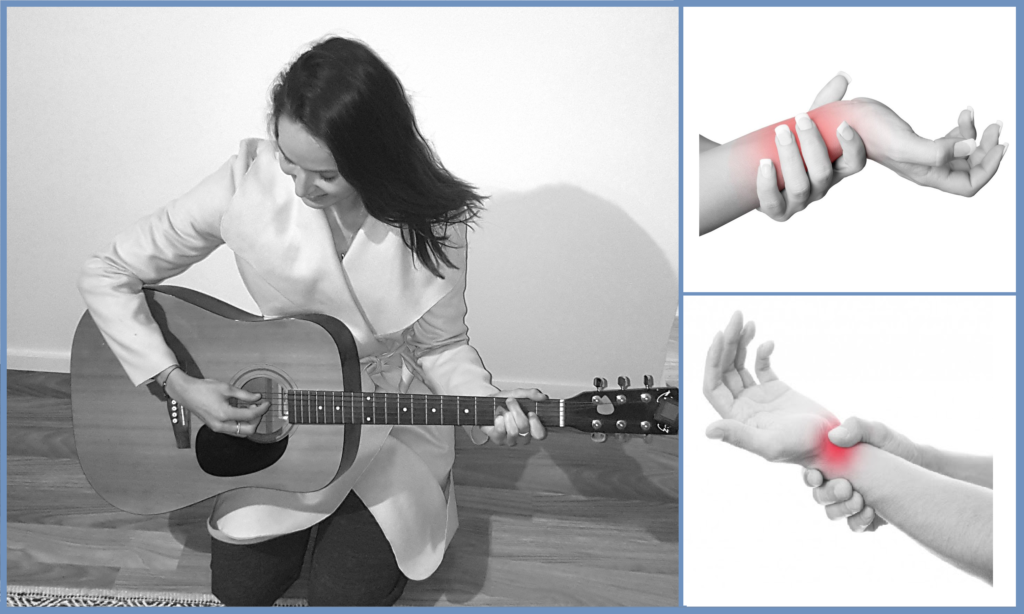 Unfortunately, many guitarists, find themselves developing pain in various parts of the body due to their commitment to practicing guitar. This pain can develop into a Repetitive Strain Injury (RSI), also known as Overuse Injury.
Unfortunately, many guitarists, find themselves developing pain in various parts of the body due to their commitment to practicing guitar. This pain can develop into a Repetitive Strain Injury (RSI), also known as Overuse Injury.
Repetitive Strain Injury (RSI) is an injury of the musculoskeletal and nervous systems that may be caused by repetitive tasks, forceful exertions, vibrations, mechanical compression (pressing against hard surfaces), or sustained or awkward positions.
The 5 most common guitar related hand injuries are:
- Nerve compression syndromes
- Tendonitis
- Tennis elbow
- Focal dystonia
- Arthritis
1- Nerve compression syndromes
Carpal tunnel syndrome
Carpal tunnel syndrome very often occurs in stringed guitarists and other stringed instrument musicians who use to play with their wrists in excessive flexion. The compression of median nerve in the wrist leading to complaints like tingling, pain, numbness or discomfort in the fingers.
Cubital tunnel syndrome
This syndrome is caused due to ulnar nerve entrapment as the nerve passes through the cubital tunnel in the elbow region. It usually only involves the ring and pinky fingers as these are the ones with ulnar nerve supply.
2- Tendonitis
Tendonitis refers to the inflammation of tendons and guitarists commonly get it in their wrists leading to tightness of muscle, connective tissue constriction and pain. Wrist tendonitis it is caused due to friction and strain produced due to overuse of the wrist muscles.
3- Tennis Elbow
Tennis elbow, also known as lateral epicondylitis, is an inflammatory process which occurs in the elbow. The main symptoms include pain on the outside edge of the elbow, pain when gripping especially while extending the hand at the wrist. In guitarists, the main cause leading to this injury is over-practicing and putting extra pressure on the fretboard than necessary.
4- Focal Dystonia
Focal or functional dystonia are painless, stereotypic, localized movements encountered in some professional groups of patients that perform many times per minute the same tasks. Several fingers on a musician’s hand just curl up and stop responding.
5- Arthritis
Arthritis is the wear and tear of joints, and for guitarists this most commonly occurs in the hand, wrist, elbow and shoulder. It usually occur at the carpometacarpal joint of the thumb and may lead to instability. The most common cause is osteoarthritis where joints get worn down through overuse and begin grinding against each other.
Prevention:
- Warm and stretch your fingers before playing.
- Don’t hang your guitar too low so that you need to flex your wrist more.
- Avoid practising and performing for lengthy period of time and take breaks.
- Always try and keep your wrist as straight as comfortably possible.
- Icing 20-30 minutes after prolonged effort will reduce inflammation and reduce potential damage.
- If you experience pain, swelling, or weakness then stop playing and seek advice from doctor.
- Drink plenty of fluids to prevent dehydration.
Diagnosis:
The diagnosis of RSI is clinical and is based on history and examination. Medical Imaging examination such as X-ray, MRI or Utrasonography may be used to evaluate for alternative diagnoses, as well as further studies such as electromyography/nerve conduction studies and blood tests.
Treatment:
Hand and upper extremity disorders of the musicians should not be treated surgically and guitarists are no exception. Surgery should always be considered a last resort. Treatment may involve:
- Physical therapy
- Psychological support
- Rest
- Use of braces
- Use of medicines, ice, vitamins, essential fatty acids, etc.
- Use of muscle gel or deep heat
For further information- Guitar related hand injuries: Prevention and Treatment | MEDCHROME